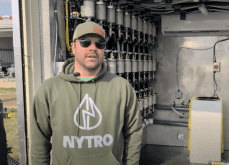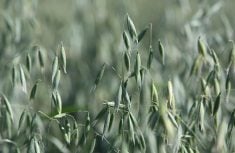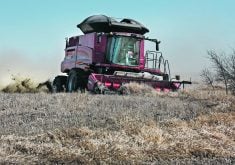SASKATOON – Twin nozzles have been around for a few years, but an Agriculture Canada research scientist from Saskatoon says they’re best at controlling fusarium head blight.
“It’s one of the unique cases where the wheat head is the target,” Tom Wolf told the recent Saskatchewan Soil Conservation Association conference in Saskatoon.
“It’s a vertical target and it must be hit from both sides because the fungicide doesn’t translocate.”
Wolf said the nozzles, which spray forward and backward, can be manufactured in a variety of combinations. A twin cap allows farmers to put different nozzles forward and back, but they can also buy nozzles out of the box that have two orifices that spray both forward and backward.
Read Also

VIDEO: Ag in Motion documentary launches second season
The second season of the the Western Producer’s documentary series about Ag in Motion launched Oct. 8.
“There’s a lot of opportunity there for improving your targeting of the spray. We thought, ‘this is a cool idea. Why not translate that into a grassy weed situation, where we also have a vertically oriented target, which we should also try to hit from as many sides as possible,’ “he said.
“We’ve been doing some work, some with Eric Johnson in Scott, (Sask.,) and we’re finding most of the time the double nozzle doesn’t seem to give us a real benefit in the herbicide world.
“It’s probably because the targeting is much more variable. We don’t have that single, erect wheat head. We have a number of leaves going straight up, flopping over, intertwined with each other, underneath the canopy partly shielded, and so on. The advantage of that increased targeting doesn’t really manifest itself.”
Wolf told producers there’s nothing wrong with using the more expensive twin nozzles, but they’re probably not going to see a benefit every time.
“Because you have to split your water volume through two nozzles, they’re going to be smaller nozzles and will make a finer spray. So there could be drift issues,” he said.
“I recommend if you go to a double nozzle, use two low-drift spray nozzles. Both the front and the back should be low drift, so it reduces your drift and gives you more effective trajectory control. It stays that way for a longer time. Whether you’re going to see better control, it’s pretty rare.”
Wolf said he has done studies where he looked at the penetration of a double spray into a crop canopy.
“It was a pulse crop in this case. We couldn’t demonstrate any better penetration, but we did find water volume was able to penetrate that canopy much better. If you want to go through a canopy, two pieces of advice: more water and slower travel.”
Slower travel allows the nozzle to develop its own form of air assist that carries the spray further into the crop, but it depends on the kind of canopy.
“If you have a vertically oriented canopy, with a target a cereal crop, for example, slow travel speed with vertically oriented nozzles is a good idea.”
“But if you have a pulse canopy with more broad leaves and is more dense, then penetrating that way is impossible. Then you may have to use the forward-backward idea to get it through.”














